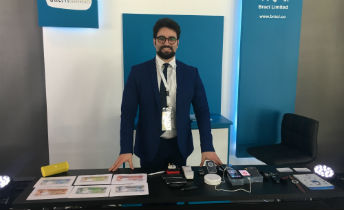Traditional fire or intruder alarms are effective because they alert people by making some kind of noise. But what if the user is deaf or has hearing issues?
Security solutions have become an integral part of modern life. Homes to offices to public places and commercial spaces are now protected by electronic security technology. Obviously, these solutions are helpful in protecting people and infrastructure and they are efficient at this job – at least for the most part.
As with everything, there are exceptions to this as well. Traditional fire or intruder alarms are effective because they alert people by making some kind of noise. But what if the user is deaf or has hearing issues? How can they know when an alarm goes off? Before you dismiss this saying it wouldn’t be a major issue in most cases, think of security solutions in care homes or nursing homes where elderly people live. There would be many people in such places who would have difficulties in hearing. So how would you ensure that they hear a fire or an intruder alarm?
From strobe lights to ‘wasabi’ to alert deaf people
According to the National Fire Protection Association (NFPA), a global nonprofit organization devoted to eliminating death, injury, property and economic loss due to fire, electrical and related hazards, smoke alarms save lives, but those who are deaf or hard-of-hearing
cannot depend on the sound of the regular alarm to alert them to a fire.
In places that have such people, NFPA recommends the use of alarms with strobe (flashing) lights that have been tested by an independent laboratory. The alarms for sleeping areas with strobe lights should be of a high intensity that can wake up a sleeping person. But even this may not be enough, as the organization points out that research has shown that older adults are unlikely to respond to alarms with strobe lights.
According to a
study published by the Ear and Hearing journal, alarms with strong lights are not particularly effective. However, a small vibrator under the pillow could help people with severe or total hearing loss, while alarms with low-frequency sounds could be effective for people with mild or moderate hearing loss. Such a vibrating pad is recommended by
some government authorities too.
But even these cannot be considered as comprehensive solutions. For instance, if a person with total hearing loss is not near an object like a pillow that can vibrate, there is no way of letting him or her know of the alarm.
Some researchers have looked for more unconventional solutions. Scientists from
Shiga University of Medical Science in Japan once
 Japanese researchers developed an alarm system
Japanese researchers developed an alarm system
that relied on the pungent smell of wasabi.
developed an alarm system that relied on the pungent smell of wasabi (Japan’s spicy green horseradish often served with sushi) to wake up people who might have slept through a conventional fire alarm. Although it reportedly found several customers, we are yet to see something like it in the international market.
The search for other effective solutions
As a University student, Anwar Almojarkesh was a heavy sleeper who had difficulties waking up in the morning for classes. It was not that he didn’t want to attend the classes, he just couldn’t wake up. So Almojarkesh invented a ‘splash alarm’ to splash water on him in the morning to wake him up. Now, not everyone might like to have water splashed on them first thing in the morning, so he then developed an idea of a pillow that would vibrate in the morning.
One thing led to another and soon Almojarkesh came up with the idea of a vibrating bracelet that could be connected to an app on a smartphone, which, in turn, can be triggered by the sound of an alarm clock.
That’s when it dawned on him that this little, personal invention of his could actually have a much larger scope. “I realized that deaf people and those with hearing issues can use such a solution to know when something like a fire alarm, doorbell, smoke alarm, theft alarms or similar equipment goes off around them,” Almojarkesh said.
And this was how the
Braci1 was born, a Birmingham, U.K.-based startup that makes smart algorithm on smartphones that can detect and recognize emergency sounds such as alarms and doorbells to alert deaf and people with hearing issues, so that that they can take adequate measures to protect themselves. The company, of which Almojarkesh is the founder and CEO, claims to be using the most advanced sound recognition technology that can detect sounds in real time and relay them to wearable gadgets like smartwatches.
“Our product contains four main parts,” said Almojarkesh. “One, the core algorithm (software app installed on the phone) which does the analysis of the sound. Two, a smartphone: iPhones or Android software that uses the microphone of the phone to detect the sounds. Three, a smartwatch and vibration pad to alert users by vibration while their phones are away and four, an external microphone to extend the range of hearing up to 30 meters.”
Almojarkesh added that as technologies develop, their main goal is to allow the app to detect sounds without it having to be trained beforehand. This could make the solution smart-enough to make intelligent decisions on its own when detecting a sound.
 Anwar Almojarkesh, Founder and CEO, Braci1
Anwar Almojarkesh, Founder and CEO, Braci1
Wearables and new technologies could be the key
It is crucial that deaf people are provided the right solutions to protect themselves in the event of a crisis. However, even though there have been some efforts to come up with innovative solutions, the results are clearly underwhelming. Clearly, security companies have not given much thought to this issue or they don’t think investments in it can bring considerable returns.
Of course, solutions like that of Brac1 are a step in the right direction. The fact that the company is working towards improving their solution, taking advantages of developments in fields like artificial intelligence, is commendable.
Ultimately, wearable technologies could be the answer to this problem, as gadgets like smartwatches can be on people most of the time and can communicate with other devices. Next step should be connecting fire/intruder alarms and even doorbells with these gadgets directly without the need for them to detect sound first.